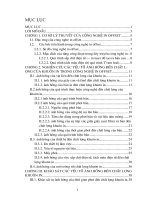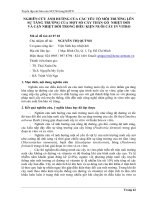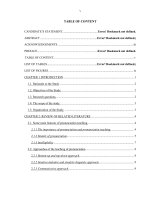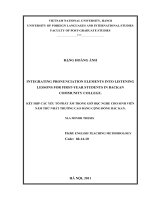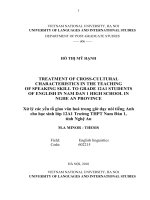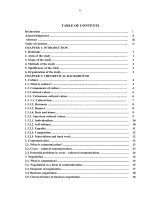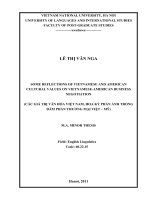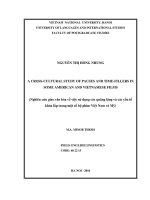Translation strategies of cultural items in poems of ho xuan huong spoonerism, idioms = chiến thuật dịch các yếu tố văn hóa trong thơ hồ xuân hương nói lái, thành ngữ
Bạn đang xem bản rút gọn của tài liệu. Xem và tải ngay bản đầy đủ của tài liệu tại đây (868.15 KB, 48 trang )
VIETNAM NATIONAL UNIVERSITY, HANOI
UNIVERSITY OF LANGUAGES AND INTERNATIONAL STUDIES
FACULTY OF ENGLISH LANGUAGE TEACHER EDUCATION
GRADUATION PAPER
TRANSLATION STRATEGIES OF CULTURAL
ITEMS IN POEMS OF HO XUAN HUONG :
SPOONERISM, IDIOMS
Supervisor: Ms. Nguyen Thi Hai Ha, MA.
Student: Pham Mai Hoa
Course: QH2017.F1.E22.PDCLC
HÀ NỘI – 2021
2
ĐẠI HỌC QUỐC GIA HÀ NỘI
TRƯỜNG ĐẠI HỌC NGOẠI NGỮ
KHOA SƯ PHẠM TIẾNG ANH
KHOÁ LUẬN TỐT NGHIỆP
CHIẾN THUẬT DỊCH CÁC YẾU TỐ VĂN HÓA
TRONG THƠ HỒ XUÂN HƯƠNG : NÓI LÁI, THÀNH
NGỮ
Giáo viên hướng dẫn: Nguyễn Thị Hải Hà, MA.
Sinh viên: Phạm Mai Hoa
Khoá: QH2017.F1.E22.PDCLC
HÀ NỘI – 2021
2
ACCEPTANCE PAGE
I hereby state that I: Pham Mai Hoa, a student of QH2017.F1.E22PDCLC, being
a candidate for the degree of Bachelor (English Language) accept the requirements of the
College relating to the retention and use of Bachelor’s Graduation Paper deposited in the
library. In terms of these conditions, I am of the opinion that the origin of my paper
deposited in the library should be accessible for the purposes of study and research, in
accordance with the normal conditions established by the librarian for the care, loan or
reproduction of the paper.
Signature
Hoa
Pham Mai Hoa
30/04/2021
TABLE OF CONTENTS
Acknowlegement………………………………………………………………… i
Abstract…………………………………………………………………………... ii
List of abbreviations and figures………………………………………………… iii
CHAPTER I: INTRODUCTION…………………………………………………. 1
1.1. Research problem and rationale for the study
1.2. Research objectives and Research questions
1.3. Significance of the study
CHAPTER II: LITERATURE REVIEW………………………………………… 4
2.1. Previous research
2.2. Theoretical framework
2.3. Translation strategies
CHAPTER III: RESEARCH METHODOLOGY………………………………..20
3.1. Research design
3.2. Selection of subjects
3.3. Sampling
3.3. Data collection
CHAPTER IV: FINDINGS AND CONCLUSION………………………………24
4.1. Research question 1
4.2. Research question 2
CHAPTER V: CONCLUSION AND SUGGESTIONS FOR FURTHER
RESEARCH……………………………………………………………………...31
1. Conclusion
2. Limitations and suggestions for further research
REFERENCES…………………………………………………………………...37
ACKNOWLEDGEMENT
First of all, I would like to extend my most sincere gratitude toward my
supervisor, Ms. Nguyen Thi Hai Ha, MA - Lecturer of Faculty of English Language
Teacher Education. Her constructive suggestion and considerable encouragement were
a springboard that uplifted me to conduct this study.
Moreover, I am filled with the huge gratefulness for my family and friends who
have forever inspired me to devote my time and effort to completing this piece of thesis
paper. It is my sheer privilege that they have shouldered me with mental and financial
burden and their love has empowered me considerably to muster enough bravery and
dedication and passion for pursuing this tough path.
I am also thankful to the producer of the music piece named “Late night
melancholy” which helped to sooth my soul a lot whenever the mental breakdown came
at me during the research process. Moreover, the magic music he/she made has
stimulated the sense of creativity which was necessary for completing this task.
Furthermore, I would like to offer my warmest regards to myself, who decided not to
give up on researching even though it seemed a daunting task to her. Thank “you” for
your effort to learning from mistakes and growing up this far.
Last but not least, I would like to express my heartfelt gratitude to all the readers
who may spend their specious time working on this study. All your constructive
feedback is strongly appreciated and I owe all of you a deep debt of gratitude. I hope
that this thesis may share your burden in your academic work.
i
ABSTRACT
Idiom and spoonerism translation have long been the great concern of linguists
and translators due to their distinctive linguistic features and aesthetic complexity.
Thus this research made an all-out effort to analyze all possible translation
strategies that could be used in rendering idiomatic and spoonerized phrases appearing
in Spring Essence by John Balaban based on the theoretical framework proposed by
Baker. With the set of data collected from 49 Ho Xuan Huong’s poems, the researcher
mostly used the qualitative method to reach the final result.
The finding indicated that four out of five strategies which were introduced by
Mona Baker were applied in the English version namely using an idiom of similar
meaning and dissimilar form, translation by paraphrase, translation by omission,
translation by reduction. The translator also adopted another strategy called literal
translation due to its effectiveness of rendering almost all types of translation objects. In
respect to frequency, translation by paraphrase was dominantly used, followed by literal
translation. In contrast, the translator failed to apply the strategy of using an idiom of
similar meaning and form.
ii
LIST OF ABBREVIATIONS
Abbreviation
Full form
ST
Source text
TT
Target text
SL
Source language
TL
Target language
LIST OF TABLES
Table
Page
Table 4.1: Strategies used to translate idioms and spoonerism in
26-27
English translations of Ho Xuan Huong’s poems
iii
CHAPTER I. INTRODUCTION
This chapter specifies the statement and rationale for the research. Moreover,
the objectives and significance are also mentioned with detail.
1.1 Statement of the research problem and rationale for the study
1.1.1 Statement of the research problem
Translation can be described as a process of code-switching of at least two
languages incorporating with cultural and linguistic transfer between them.
Accordingly, translation, as a means of transferring languages as well as cultures, is
playing a significant role in today’s international communication. It has already given a
great impetus to the exchange of the cultures and the development of the mankind,
without which the world would be a different one (Xuxiang, 2015). It is well-observed
that cultural diversity among countries, to some extent, has led to many barriers and
challenges in translation field. Specifically, poetry translation is deemed a daunting task
to both translator and researchers working on the literary translation field. Accordingly,
translation of poetry as a yet unanalyzed “black box” (Francis, 2006) has been intensely
debated with lateral opposing ideas about faithfulness that the TT can achieve. This is
due to the high cultural prestige of poetry which requires time, effort, ingenuity to
translate rhyme, rhythm, the figurative language involved (Hossein, Haadi, Zahra,
2008).
Vietnamese Medieval poems are the quintessence of folk culture that was the
ultimate embodiment of Vietnamese mind and creativity. Meanwhile folk culture was a
sophisticated incorporation between culture-rich contents and linguistic forms. This
leads to the situation where not all the aspects of a medieval poem are translatable due
to the cultural void in inter-cultural context and the fact that each language has its own
lexical structure. Specifically, idioms and spoonerisms are vivid illustrations in this
case. Therefore, idioms and spoonerism applied in Vietnamese medieval poems are
among troublesome figures of speech challenging a translator. Consequently, not quite
1
a few poems in this era have been rendered cross-culture, stifling development of
Vietnamese literature to the culture-rich world literature.
Among remarkable medieval poems, Ho Xuan Huong’s works can be considered
as the perfect symbol for harmonizing between excellent usage of idioms and
spoonerism and brilliant feminist-supporting ideas behind her poems. With such a
distinctive style, her poems were acclaimed as “both elegant and erotic”. The enormous
amount of works written in Nom language explains why Ho Xuan Huong was praised
as “the goddess of Nom poems”.
1.1.2 Rationale
There are some factors leading to my decision on choosing Ho Xuan Huong’s
poems and their translated version as the object of the research. First, medieval
literature embracing quintessential folk culture is of the researcher’s passionate interest
because of its outstanding values and distinguished features. Therefore, conducting
research on one of the most extraordinary poems of the era – poems of Ho Xuan Huong
is undoubtedly a wise choice. Second, as it can be well-observed, there is hardly any
insightful research lifting the veil of the art of using cultural items, especially idioms
and spoonerism in Ho Xuan Huong poems albeit abundant studies working on many
linguistic features. This situation aroused the researcher’s insatiable curiosity, which
motivated the researcher greatly. Third, the translated version by John Balaban was a
hit with readers, scholars or professional literary translators that paid attention to
Vietnamese literature – sold out 16 million copies in 2 years. All things considered, Ho
Xuan Huong’s precious poem and its timeless value are by all means a worthy
objection for an academic research which is believed to be a bridge linking Vietnamese
medieval literature to the world.
1.2 Objectives and research question
1.2.1 Objectives
The objectives of the study are:
2
• To identify idioms and spoonerism frequently used in the poems of Ho
Xuan Huong
• To investigate translation strategies applied in the English version.
• To draw some implications on translating idioms and spoonerism in
poems and provide some recommendations for further research.
In a view to achieving these objectives, the research attempts to answer
following research questions:
1. What strategies are employed by John Balaban to translate idioms and
spoonerism used in “Spring Essence: The Poetry of Ho Xuan Huong”?
2. What are the most frequently used strategies in English version?
1.3 Significance of the study
The research is expected to make a useful contribution to bridge the gap in
translation of idioms and spoonerism in a Vietnamese-English language pair.
First, the study attempts to provide professional literary translators with
insightful analysis of theoretical framework. Readers can consider this as a referential
material in the translation process of other literary works containing idioms and
spoonerisms thus they can make a wise choice of the most effective strategies.
Second, the thesis included in the study may fill the gap in idioms and
spoonerisms translation theories since the study highlights the theoretical overview of
cultural items translation strategies. This can enhance the readers’ ability to gain
profound knowledge and useful material for cultural items translation in general.
Hopefully, literary translation in Vietnam can therefore flourish and bring
Vietnamese literature out of its border and make it outstanding in comparison to other
country’s literature.
3
CHAPTER II. LITERATURE REVIEW
In this chapter, the researcher provides thorough review about the previous
research and extensive knowledge on the theoretical framework related to her
research.
2.1. Previous research
In this part, the research will provide some reviews about the related study to
expose the similarity and difference from the research and the previous one. Therefore,
the contribution of this research to literary translation can be identified clearly. There is
a study about translating strategies used in English version of Ho Xuan Huong poems
which is reviewed in this paper.
The research named “the investigation into the stylistic devices commonly used
in Ho Xuan Huong poems and their English versions” was carried out by Ms. Tran
Hoang Mai. In this piece of paper, the researcher focused mainly on 4 SDs namely
proverbs, saying, onomatopoeia, antithesis and pun in 37 poems of the book “Spring
essence: the poems of Ho Xuan Huong” edited and translated by John Balaban. As for
the size of sample, the research reached to 224 samples which contained 122 samples in
Vietnamese version and 122 their equivalents in English. With an aim to analyze such a
large size of samples effectively, the researcher launched the investigation based on the
combination of quantitative, qualitative, descriptive and comparative methods. What’s
more, the in-depth analysis in this research was performed systematically and because it
was based on the theoretical frame work introduced by Galperin and ĐìnhTrọngLạc in
terms of SDs and the point of view proposed by Newmark and Baker in terms of
translation strategies.
Consequently, it can be observed from the finding of this research that SDs such
as proverbs, sayings, onomatopoeia, antithesis and pun are such a daunting task for the
translator to make full use of translation strategies since in some case none of them
worked. However, the translator made every effort to render the meaning of Ho Xuan
Huong’s poems. As can be observed, the percentage of literal translation usage in
4
translating antithesis and onomatopoeia is highest with 66.7% and 43.5% respectively.
Meanwhile, in translating pun, the translator mainly used notes, additions, glosses,
making up 63.9% among total translation strategies. Regarding idioms, proverbs and
sayings, the percentage of the most frequently used translation strategy – paraphrase is
42.9%. Along with the conclusion on usage of SDs in target text, the paper also
mentioned SDs teaching, learning and translation. The key term mentioned in this part
is “knowledge” since mastering SDs learning, teaching and translation means that
profound knowledge about SDs in both languages is extremely needed.
After considering the research, I was well-aware of the strengths and weaknesses
of the research, which gave me a chance to perfect my paper. First of all, mentioning
strength, I suppose that the combination of quantitative, qualitative, descriptive and
comparative methods make the research be analyzed comprehensively and extensively.
Moreover, the finding sounded convincing when supported by figures and detailed
evidences. Second, the limitation is unavoidable. The theories reviewed were listed
without examples and explanation, which may confuse the reader. Furthermore, while
assessing the effectiveness of translation strategies usages, the researcher was expected
to carry out the assessment based on a reliable framework and then analyze the
translation quality achieved after using those strategies rather than giving some
comment based on his/her point of view, making the research more subjective and
unconvincing. What’s more, the conclusion on SDs teaching, learning and translation
would have been more intriguing and helpful of the research provided with more indepth information with more well-evident and thorough analysis. All the weaknesses
mentioned above are the obvious gap that should be filled on a purpose of producing a
more detailed and profound research on Ho Xuan Huong’s poems.
My research is conducted with an aim to keep up the good work of the previous
study and complete the voids that were left in that paper.
5
2.2. Theoretical framework
2.2.1. Idioms
2.2.1.a. Definition
According to Hossein (2011), idioms are linguistic expressions or lexical items
representing objects, concepts or phenomena of material life particular to a given
culture. It was also defined as “a string of words whose meaning is different from the
meaning conveyed by the individual words” (Larson, 1984). What’s more, Borah and
Sharma (2016) were of an opinion that an idiomatic phrase or sentence consists of an
idiomatic expression containing a special meaning in a special context. Whereas, Mona
Baker in “Other Words” (1992) gave a definition that idioms are frozen patterns of
language which allow little or no variation in form and often carry meanings which
cannot be deduced from their individual components. So by stating this definition she
considers five conditions for idioms which come as follow:
• The order of the words in an idiom cannot be changed. The way the words are
put together is fixed and they cannot change their place. For example: “rain cat and
dog” not “rain dog and cat”.
• The words in an idiom cannot be omitted. We as the users of the language are
not permitted to delete some of the words of a particular element. For example: “make
a long story short” not “make a story short”.
• There are no extra words that might be added to an idiom. For example:
“under the weather” not “under the bad weather”.
• No words in an idiom can be replaced by another word. For example: “no pain,
no gain” not “no hurt, no gain”.
• The grammatical structures of an idiom cannot also be changed. For example:
“pull someone’s leg” not “someone’s leg is pulled”.
As a result, the translator should master both languages and be extremely
knowledgeable of their cultures since it is highly recommended to render the meaning
of idioms after considering cultural and linguistic aspects of both languages.
6
2.2.1.b. Classification
Idiom translation is obviously a daunting task due to the enormous disparity
between various languages. Therefore, it is believed that being well aware of idioms
classification is a must in order to carry out the qualified version of idioms translation.
The classification of idioms proposed by different researchers varies with different
approaches. Hossein (2011) mentioned five groups of idioms namely colloquialism,
proverbs, slang, allusions and phrasal verbs. For more explanation, he proposed that
colloquialism referred to an expression which is not advisedly applied in formal writing
or speech. Proverbs were defined as “a traditional, conversational, didactic genre with
general meaning, a potential free conversational turn, preferably with figurative
meaning" (Norrick, 1985). “When in Rome, do as Rome” is a typical proverb. As for
slang, Jakaitienė (1980) and Vosilytė (1991) described slang as emotive, expressive and
colourful, though different from the standard language. For example, “bromance” is a
slang implying the friendship between straight boys. Regarding allusions, Hossein
(2011) mentioned that allusion is a figure of speech that makes a reference to a place,
event, literary work, myth, or work of art, either directly or by implication. Taking
“Pandora’s box” as an example for an allusion, this term alludes to the Greek story of
Pandora who accidentally released evil into the entire world. Last but not least, phrasal
verbs were described as “the combination of a verb and a preposition, a verb and an
adverb, or a verb with both an adverb and a preposition” (Hossein, 2011). A phrasal
verb bears a meaning that is extremely different from the rooted verb. For example,
“run into somebody” means having an accidental meeting with someone.
However, Ho Xuan Huong poems were written in Nom character1with totally
identical linguistic features, the researcher will categorize idioms employed in Ho Xuan
Huong’s Poems based on the study of Nguyễn Đình Hiền (2018) and Hồng Thị Yến
(2017). They provided a classification of Vietnamese idioms based on structure. First,
Nom language or “chữ Nôm” in Vietnamese refers to a logographic writing system Vietnamese people created
based on Han characters with an aim to scripting Vietnamese words and Chinese-origin ones. Chu Nom was
created and used widely from 13th century to 20th century.
1
7
symmetrical idioms are the idioms containing two symmetrical parts with an “axis” in
the middle. Most Vietnamese idioms have an “even number” of components. However,
a proportion of Vietnamese idioms can also contain an “odd number” of components
and the symmetry between two parts is still retained. In these idioms, the verbs in the
middle are “axes” of the idioms. Second, comparative idioms (similes) are stable
combinations originating from representative comparisons. The third type is ordinary
idioms which are neither symmetrical nor comparative, and are usually fixed phrases.
2.2.2. Spoonerism
2.2.2.a. Definition
Spoonerism is a speech error allowing parts of two spoken words including
consonants, vowels, and tones to be switched to rearrange into two different words that
can be used to entertain or to criticize. According to Marlys and Hanh (2006), “noi lai”
or spoonerism was defined as “a linguistic device in which parts of two spoken words
can be switched to construct two other implied words''. The switch between terms
occurs flexibly. If the phrases consist of three terms, the middle word can be left intact.
If a four-word unit is spoonerised, the third word from the left is kept in place. Due to
its unique forming, a spoonerized word in most cases contains two layers of meaning.
Take the below example:
The speaker’s utterance
The intended meaning
Đại phong => gió lớn => đổ chùa => TƯỢNG LO
(fierce wind destroys the pagoda, which makes the its
(Buddha) statues worried)
Lọ tương (Jar of of
fermented sauce)
Mentioning its origin, “Spoonerism” is named after William Archibald Spooner,
who was a famous professor for making spoonerism due to his old age. And the term
“spoonerism” was officially introduced in 1921. Meanwhile, Marlys and Hanh (2011)
proposed that “nói lái is an oral folk form, highly valued and used productively, widely,
and creatively by Vietnamese speakers for centuries, long before literacy moved from
the elite class and became widespread in the twentieth century.” People often use
8
spoonerised words in both written form such as poetry and oral form such as music and
folk tale.
In Vietnamese literature, Ho Xuan Huong is one of the most excellent poets
using spoonerism to demonstrate implied ideas which can be considered “erotic or
profane”. What’s more, her usage of spoonerized words were highly appreciated when
she used spoonerized words with an aim to satirize and criticize the indulged and
corrupted groups of people in the community. Spoonerism is believed to her applying
creativity to the greatest level and her sharp sword attacking the dark side of the
society.
2.2.2.b. Classification
With a view to deeper understanding about spoonerism, several ways of
categorization have been introduced.
According to Thai Hoang & Xuan Khoai (2018), spoonerism can be categorized
in two identified groups namely Type 1 and Type 2. While Type 1 refers to the
spoonerism occurring when “only the forward form can appear in a sentence”, Type 2
is the case in which “both forward and backward form of spoonerism can appear in a
sentence”. Take the below examples:
a. Type 1
The speaker’s utterance
The intended meaning
Cờ Tây
Cầy tơ
(Eastern Chess)
(Dog)
The speaker’s utterance
The intended meaning
Đầu tiên
Tiền đâu
(First)
(Where’s the money?)
b. Type 2
What’s more, Marlys and Hanh (2011) introduced eight groups of spoonerism in
Vietnamese language. With each type of spoonerism, the researcher will take one
example to illustrate the language phenomenon. Since spoonerism is considered as an
9
oral type of wordplay used in daily life, little is the source of these below examples
found in academic pieces of literary work.
a. Type 1
In this case, the vowels and final consonants switch while the initial consonants
and the tone are left intact. As for the syllabus structure, it is mentioned that the rhyme
also swaps except for the tone as mentioned above. It, therefore, can be diagrammed as
followed:
The original utterance
The spoonerised utterance
Term 1
Term 2
Term 1
Term 2
C1 V1 C1
C2 V2 C2
C1 V2 C2
C2 V1 C1
An example for this type is provided as followed:
The original utterance
The spoonerised utterance
Term 1
Term 2
Term 1
Term 2
Thằng
Tây
Thầy
Tăng
Meaning: thằngTây: Western guys
Meaning: thầy Tăng: monks
(addressed without respect)
(addressed with respect)
As can be seen from the illustration, the first consonant (“Th”) and the grave
accent are kept in the exact place while the vowels (“â” and “ă”) and the final
consonants (“ng” and “y”) and the rhyme swaps together between two terms. In this
context, “thằng Tây” refers to Western soldiers with the disrespectful attitude while its
spoonerised term mentions the Vietnamese monks in the tone of fullest respect.
b. Type 2
In this type, only do first consonants switch between terms, meanwhile, the rest
will stay unchanged. The diagram of this type can be drawn as:
The original utterance
Term 1
Term 2
The spoonerised utterance
Term 1
10
Term 2
C1 V1 C1
C2 V2 C2
C2 V1 C1
C1 V2 C2
For example (according to Marlys and Hanh):
The original utterance
The spoonerised utterance
Term 1
Term 2
Term 1
Term 2
Đủ
ngói
Ngủ
đói
Meaning: đủ ngói: enough tiles
Meaning: ngủ đói: sleeping while hungry
Considering the example, we can see that the swapped onsets and the
unchanged part of two terms (“đ” and “ng”) in one unit help form a new word whose
meaning is given totally differently. In this context, these two words refer to the fact
that the house built with enough tiles may lead to the fact that the owner of the house
will have to sleep with an empty belly when the building is completed because buying
enough tiles for the house can cost a fortune.
Another example:
The original utterance
The spoonerised utterance
Term 1
Term 2
Term 1 Term 2
Mèo
đứng
Đéo
Meaning:
standing cat
mèo
đứng:
mừng
a Meaning: đéo mừng: no fucking
celebration
This example takes reference from a folk story about Mr. Thu Thiem. In this
context, some fancy weddings were held just to show off, meanwhile, other citizens in
the society suffering from severe poverty and famine. When invited to that one, Mr.
Thu Thiem decided to present the family with one piece of silk writing: “Miêu bất tọa”.
This phrase literally means “a cat which doesn’t take a seat” then it has to be a standing
cat, which is spoonerized into “No celebration”. In this case, he used spoonerism to
express his criticism and hatred toward bad customs in the society.
c. Type 3
11
In type 3, only the first consonants of both terms remain unchanged, the rest
containing the vowel, the final consonants, and the rhyme switch together. The
interchange of rhymes helps distinguish this type to the first one. We can work the
diagram of this type out as below:
The original utterance
The spoonerised utterance
Term 1
Term 2
Term 1
Term 2
C1 V1 C1
C2 V2 C2
C1 V2 C2
C2 V1 C1
Take an example:
The original utterance
The spoonerised utterance
Term 1
Term 2
Term 1
Term 2
Thầy
giáo
Tháo
giầy
Meaning: thầy giáo: teacher
Meaning: tháo giầy: taking the shoes off
As can be observed, the first consonants (“th” and “gi”) are left intact.
Meanwhile, the vowels (“ây” and “áo”) and the acute and grave accent switch flexibly.
In this context, we can put “thầy giáo” and “tháo giầy” together to form a sentence
depicting the scenario where the teachers had no choice but quitting their job (taking
their shoes off) due to the fact that they could not earn their livings.
Take another example:
The original utterance
The spoonerised utterance
Term 1
Term 2
Term 1
Term 2
Nhắc
bạn
Nhạn
bắc
Meaning: nhắc bạn: reminding friends
Meaning: nhạn bắc: the northern swallow
In this case, the onsets of two terms are left unchanged, however, the vowels
(“ă” and “a”) and the final consonants (“c” and “n”) swaps. Even the rhymes within
two terms switch along with the consonants and vowels.
d. Type 4
12
In the fourth type, the first consonants and the vowels switch, while there is no
change in the final consonant. The rhymes can be unchanged. This type can be
diagrammed as:
The original utterance
The spoonerised utterance
Term 1
Term 2
Term 1
Term 2
C1 V1 C1
C2 V2 C2
C2V2 C1
C1V1 C2
Take an example:
The original utterance
The spoonerised utterance
Term 1
Term 2
Term 1
Term 2
Lông
mép
Mông
lép
Meaning: long mép: mustaches
Meaning: mông lép: the flat butt.
In this example, the first consonants and the vowels in both terms switch
together. On the other hand, the final consonants and the rhymes see no change. As for
the text, these terms can be put together in a sentence to mock people who have
mustaches.
e. Type 5
This type of spoonerism is considered to be extremely rare when it allows to
switch only the tone between terms. The diagram is described below:
The original utterance
The spoonerised utterance
Term 1
Term 2
Term 1
Term 2
C1 V1 C1
C2 V2 C2
C1 V1 C1
C2 V2 C2
(tone changes)
(tone changes)
Let’s take this example:
The original utterance
The spoonerised utterance
Term 1
Term 2
Term 1
Term 2
Bí
mật
bị
mất
Meaning: bí mật: secret
Meaning: bị mất: be lost (“bị” refers to the
13
passive form of the verb “lose”)
As can be observed from the above example, only the tones switch while both
terms experience no transition in other elements.
Another example:
The original utterance
The spoonerised utterance
Term 1
Term 2
Term 1
Term 2
Thụy
Điển
thủy
điện
Meaning: Thụy Điển: Sweden
Meaning: thủy điện: hydroelectric
f. Type 6
In this type, as described according to Marlys and Hanh (2011), “the entire
syllable except for the tone switches”. This type can be illustrated by the below
diagram:
The original utterance
The spoonerised utterance
Term 1
Term 2
Term 1
Term 2
C1 V1 C1
C2 V2 C2
C2 V2 C2
C1 V1 C1
Take this example:
The original utterance
The spoonerised utterance
Ăn CƠM trước KẺNG
Ăn KEM trước CỔNG
Meaning: eating rice before the bell
Meaning: eating ice cream in front of the
(getting pregnant before getting married)
gate
This spoonerism is a four-word unit with a flexible way of switching. The first
and the third word in this case stay intact while the second and the final word are
spoonerized in the way as characterized in type 6. To be specific, there is a complete
change in the syllable of these words, while we hardly see any switching in tone. In this
context, the phrase “ăn cơm trước kẻng” means getting pregnant before getting married
and this seems to be quite embarrassing in Vietnamese culture in the past. Therefore, it
14
is common to spoonerize this phrase into “ăn kem trước cổng” to avoid awkward
situations.
g. Type 7
In this type, the spoonerism is embodied by switching the vowels alone. That
means the first and final consonants and the tones are kept intact. This type can be
diagrammed as followed:
The original utterance
The spoonerised utterance
Term 1
Term 2
Term 1
Term 2
C1 V1 C1
C2 V2 C2
C1 V2 C1
C2 V1 C2
Considering this example (according to Marlys and Hanh (2011)):
The original utterance
The spoonerised utterance
Term 1
Term 2
Term 1
Term 2
Cương
quyết
Quyên
Cước
Meaning: cương quyết: determined
Meaning: quyên cước: collect nylon threat
In this case, spoonerism is applied flexibly. However, we can find that only the
vowel (“ươ” and “uyê”) switch. Other elements stay unchanged.
h. Type 8
According to Marlys and Hanh (2011), “the speaker says two nonsense syllables
that when ‘reversed’ according to one of the basic six types above yield two real words
with the speaker’s intended meaning”. That means the original utterance is given
without no meaning but its spoonerized version contains messages. This type can be
described in the below diagram:
The original utterance
Nonsense terms
The spoonerised utterance
Intended terms
Take these examples:
The original utterance
Tiến tùng
The spoonerised utterance
Túng tiền
15
Meaning: no meaning
Meaning: short of money
(Type 8 + type 6/type 2)
The original utterance
The spoonerised utterance
Thanh ương
Thươnganh
Meaning: no meaning
Meaning: loving him
(Type 8 + type 1)
Considering both methods of classification, the method introduced by Marlys
and Hanh in 2011 will be exploited in the process of researching spoonerism. It stands
to reason since firstly, spoonerism itself carries complexity, which needs meticulous
observation; secondly, the categorization by Marlys and Hanh is deemed more detailed
and well-structured with much more types included.
2.3. Translation strategies
According to Lörscher, translation strategy referred to “a potentially conscious
procedure for the solution of a problem which an individual is faced with when
translating a text segment from one language to another (1991, p. 70). As above
mentioned, translators have confronted fierce troubles when rendering the meaning of
idioms and spoonerism cross-culturally. Therefore, wise translation strategies are the
key leading to unlock the “black box” of idioms and spoonerism to achieve the best
target text. Several researchers categorized translation strategies into “local” and
“global” ones (Sesguinot, 1989; Lorscher, 1991; Jaaskelainen, 1993; cited by Kearns,
2009, p.283). Meanwhile other researchers suggested the set of translation strategies
which aim to render specific types of the ST. The researcher looked into Andree
Lefevere’s strategies applied for poem translation and Mona Baker’s strategies for
rendering stylistic devices such as idioms and spoonerism.
2.3.1. Andree Lefevere’s strategies
Seven categories of translation strategies were noted by André Lefevere (1992):
a. Phonemic translation
16
